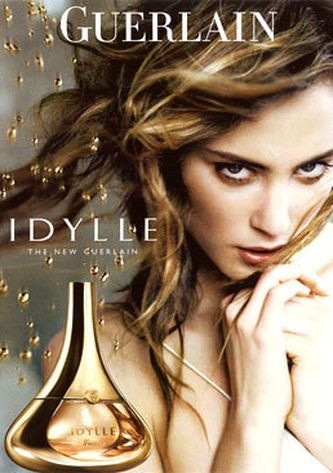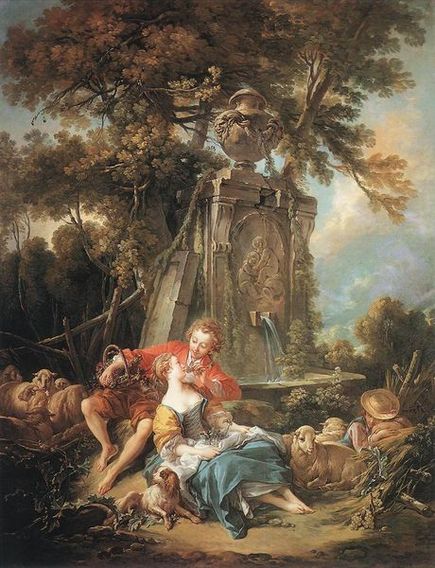Guerlain Idylle (2009) Part 1: The Evolution of Guerlain's Signature {Perfume Review} {New Fragrance}

Idylle"
means love, or the dream of love. The word refers to a poetic genre which in
Greek antiquity sang of the amours and erotic encounters of a shepherd boy and
girl in a bucolic setting. An idyll is also a song of innocence lost, expressing
feelings such as the fear of seeing beauty vanish and youth fly by all too
quickly.
As
the poet Theocrites penned in one of his idylls, "Soon your youth will fade away like a dream," thereby inviting
the young shepherd girl to experience love before it is too late.
Perfumer Thierry Wasser, who created Idylle, explained that in keeping with the Guerlain family tradition of seeking inspiration in love to compose their fragrances, he had wanted to pay homage to this long line of spiritual forefathers. The word "youthful" also appears as a key term in his presentation published on the dedicated Guerlain website. The notion of youth befits the idyll genre and the stylistic choice made here: a crisp, young yet antique rose tinged with green, which offers a millefleurs aspect like a floral tapestry (in the sense of a composition incorporating several distilled flowers.) But the approach is also more externally motivated by the house's desire to create an affective link with the younger generations of women, the customers who will ensure Guerlain's prosperity into the 21st century....

Since
the soft ambery magnolia of L'Instant de Guerlain (2003), the brand has been
developing a more modern signature based on white musks -- a strategic choice
that became explicit later on with Insolence (2006), which was said to be a
perfume made to attract a new clientele to the house's perfume counters. The
rose-violet composition is a modern adaptation of Après l'Ondée (1906) and
L'Heure Bleue (1912), by Maurice Roucel. By the time of the launch of La Petite
Robe Noire (2009) the policy was solidly established. The perfume seemed to
have been devised by the mind of a brilliant engineer, Delphine Jelk, who saw
clearly what needed to be done to build bridges across the different
generations of Guerlain customers. Its packaging was also Guerlain's first
foray into the fashion world and into a universe resembling that of the Vuitton
bags, whimsically redesigned by Marc Jacobs with cartoonish motifs (Guerlain is
owned by the Louis-Vuitton-Moet-Hennessy luxury group or LVMH).
With
Idylle we continue to see an evolution of the Guerlain signature, now under the
main responsibility Thiery Wasser, their in-house perfumer freshly adopted in
May 2008. This is not to say that
Jean-Paul Guerlain is absent from the scene. Sylvaine Delacourte, who used to
be a super artistic director and now sees part of her responsibilities taken
over by Thierry Wasser, has let out some insider's remarks on the blog she
currently writes, Esprit de Parfum.
One thing you learn is that Jean-Paul Guerlain remains at the helm of the house,
if only to give the nod of approval to the creations put out by his
"ateliers." (Former resident nose Mathilde Laurent, now at Cartier, has likened these "workshops" to
those of a master painter, where creation is supervised and then signed by the
master.) Delacourte says that each and every perfume is smelled by Jean-Paul
Guerlain. Having said that, he may not always be in a position to cast a final
veto as the forces of the market have to be taken into account. As a result of
this tension, he has not hesitated in the past to express his barely disguised
contempt for overzealous marketers.
Creation
in perfumery is a complex matter as there exists a whole chain of participants.
As Jean-Paul Guerlain himself once hinted, you can cook from scratch or order
from the traiteur, meaning in this
case the fragrance companies that provide the raw materials and bases (complex
blends used as building blocks in a perfume) that perfumers then utilize to
realize their artistic or commercial visions.
Guerlain
in this case prefers to cook from scratch: Theirry Wasser has explained that although his
taste dominates in Idylle, he has also incorporated into the composition an
ancient varietal of rose in the form of a Plessis Robinson Rose base created by
Jean-Paul Guerlain. As perfumery is also an art dependent on harvests, another
significant building block of this fragrance is a "communelle" of
Bulgarian roses from 2008, a careful mix done by the new house nose Wasser and
Jean-Paul Guerlain. This mix
blends different streaks of rose essences in order to ensure that it will still
be available when the next batch of perfume needs to be made and the
characteristic identity of the perfume preserved. The Plessis Robinson base
reportedly was a perfect match for the 2008 Bulgarian rose communelle.
In
order to understand Idylle's fresh and aquatic thrust, which many see as going
against what Guerlain stands for, it is important to remember -- in terms of
Thierry Wasser's own tastes and, I would say, his sense of personal quest --
that the perfumer has said in the past that he thinks it is much harder to
achieve lightness and freshness in a scent than the reverse. He thus remarked
on Basenotes that making Fresh Addict by Dior took him much longer than to
create the original Addict. He also confided in a recent interview given to
Osmoz that the perfume he would have most liked to create himself is L'Eau
d'Issey. The trait he admires in L'Eau d'Issey is the perfect balance between
its warmth and freshness, a dichotomy one can remark in Idylle. Finally, fresh
and light is certainly not anti-Guerlain as the Aqua Allegoria line
demonstrates. Jean -Paul Guerlain has said in the past that he was personally
very much interested in creating freshness in a perfume. One cannot be sure if
it is so because of the zeitgeist --
and a perfumer is in many ways a pleaser of crowds -- or because it is like a
dialectical challenge for a house that has thrived on opulent compositions from
the 1910s to the end of the 1980s (Samsara, 1989). If the signature of Guerlain
has been retained as one characteristically orientalist and rich, such an
impression bypasses a little too easily such a landmark perfume for the house
as the one that made it famous, L'Eau de Cologne Impériale, a sparkling fresh
eau de cologne. In fact, one quickly has to realize that Guerlain has been in
the business of creating freshness from the start. Contemporaries can agree
that L'Eau de Cédrat, L'Eau du Coq, Après L'Ondée, Le Muguet and even Chamade
with its blackcurrant bud reveal a tradition of freshness at Guerlain. It is
therefore a partial view of the history of the house to see it as only draped
in heavy velvets. More like Jicky, with its lavender-and-civet animalic
contrast or Shalimar, with its sunny bergamot and balmy leathery vanillic contrast,
or Mitsouko with it juicy peach on a bed of deep oakmoss (pre-reformulations),
the style of the house thrives on the artful contrast of warm and fresh.
Idylle
is according to this criterium alone not unlike a classic Guerlain with its
crisp, almost crunchy beginning resembling a rose watercolor tinted with
pistachio green soon followed by sueded iris, powdery and tobacco notes.
Because
it is a Guerlain in a new context, 2009, it is a rather complex object
attempting to weave tradition with l'air
du temps, as well as to make room for Thierry Wasser's special touch. In
sum, a Guerlain is in essence an institutional perfume, an entity bigger than
itself. It cannot just think of itself but has to think about the ones before
it, the ones to come; the world, and not just France. Does this Guerlain
perfume manage to be more than an interesting sociological object with many
threads running through it and is it in fact an object of perfumery art? We will try to decide tomorrow.
Part 2 of the review: Guerlain Idylle: The Creation of Longing and Beauty










Not sure what's so special about "a new context 2009" when it comes to perfumery...all I know is that I'm not 16 years old, not everybody is 16 either and I love perfumes like Une Fleur de Cassie and Attrape-Coeur (Guet-Apens).
I watched Thierry Wasser's Idylle interview on Marie Ange Horlaville's TV5monde show, all I heard was young, young, young, fresh, fresh, fresh, innocence and feminine design...how groundbreaking!
Guerlain Idylle is a cross between Narciso Rodrigez For Her EDP and Sarah Jessica Parker Lovely; it's not what I expect from Guerlain, it's just more of the same commercial stuff that's out there.
This was also my initial reaction, but then it was difficult for me to ignore the fact that there is more to Idylle than just a rehash of Narciso Rodriguez for Her.
I think that Thierry Wasser managed to "tirer son épingle du jeu," in spite of the marketing constraints. Idylle is more like a precious and light minuetto than a romantic grand waltz, but it indescribably lovely when experienced properly, I think.
It will probably not wow people looking for deep velvet, but it's good to be able to feel a wide range, no?
This was also my initial reaction, but then it was difficult for me to ignore the fact that there is more to Idylle than just a rehash of Narciso Rodriguez for Her.
I think that Thierry Wasser managed to "tirer son épingle du jeu," in spite of the marketing constraints. Idylle is more like a precious and light minuet than a grand romantic waltz, but it is indescribably lovely when experienced properly, I think.
It will probably not wow people looking for deep velvet, but it's good to be able to feel a wide range, no?
It's just that now even Guerlain is no longer lauching mainstream "haute" creations. Idylle is more of the same commercial perfumery. There's absolutely nothing complex, mysterious and unique about it which I expect from a Guerlain. It's become impossible to get something that's sophisticated and alluring without spending $200 on an exclusive that's hard to get and not always a masterpiece.
You know, I think that if there had been discerning blogs or perfume criticism in the decades that the classic Guerlains had been launched, there could have been some pointed remarks about the lack of creativity of the house when, say, Habit Rouge was launched after Shalimar or Mouchoir de Monsieur after Jicky. We have a vision of the "haute" creations of Guerlain, as you say, that is a bit shrouded in the mist of myth.
I agree with you that Idylle is not a mysterious fragrance, that is to my mind, true. But I disagree that it is not complex and unique. There are elements of complexity and originality in this perfume, and I had to report on those.
I also wanted to make a remark about the arguably commercial aspect of this perfume by calling attention to the fact that this is also the path that leads to classicism. If there had not been throngs of chypres, it would not have become a family of fragrances. But I think that a honest or strong perfumer must add a personal dose of thinking to a new perfume.
I don't know about the $200 bar. I think that lots of people like to feel special by paying high prices for perfume and the luxury industry knows it. L'Eau Ambrée for example is sophisticated to my nose and is not expensive. Aromatics Elixir is not expensive and smells great. Balmain de Balmain is a wonderful under-appreciated chypre that can be had for pennies at discounters...
This is a good idea by the way for a post on Great Perfumes Under $100 or perhaps even Under $50.